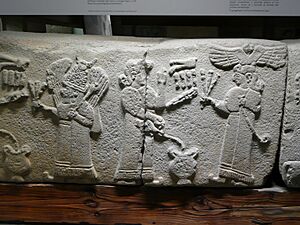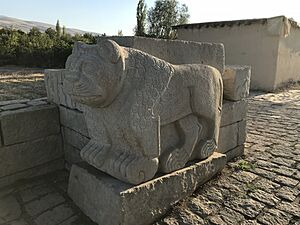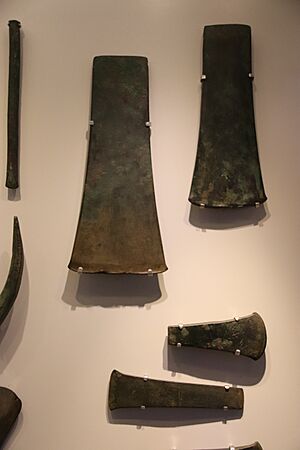Melid facts for kids
| [[File::None at this time|frameless]] | |
| Location | Turkey |
|---|---|
| Region | Malatya Province |
| Coordinates | 38°22′55″N 38°21′40″E / 38.38194°N 38.36111°E |
| Type | Settlement |
| Site notes | |
| Excavation dates | 1932-1939, 1946-1951, 1961-1968 |
| Archaeologists | Louis Delaporte, Claude F.A. Schaeffer, Piero Meriggi, Salvatore M. Puglisi, Alba Palmieri |
| Condition | In ruins |
| Official name | Arslantepe Mound |
| Criteria | Cultural: (iii) |
| Designated | 2021 (44th session) |
| Reference no. | 1622 |
| Area | 4.85 ha (12.0 acres) |
| Buffer zone | 74.07 ha (183.0 acres) |

Melid, also known as Arslantepe, was an ancient city. It was located by the Tohma River, which flows into the upper Euphrates River. This river starts in the Taurus Mountains. Today, Melid is known as the archaeological site of Arslantepe, near Malatya, Turkey.
The site was officially named a UNESCO World Heritage Site on July 26, 2021. It is recognized as the Arslantepe Mound.
Contents
Exploring Ancient Arslantepe
Early Settlements: The Chalcolithic Period
The very first people lived at Arslantepe during the Chalcolithic period. This was a time when people started using copper tools.
Arslantepe became an important place during the Late Chalcolithic period. A huge building made of mudbricks stood on top of a mound. This large building had special decorations on its walls. We are not sure what this building was used for.
Degirmentepe: Early Metalworking
About 24 kilometers northeast of Melid is a place called Değirmentepe. This site is famous for having the earliest clear proof of copper smelting. Smelting is the process of getting metal from its ore. The site was built on a small hill near the Euphrates River.
The Bronze Age: Palaces and Trade
By the late Uruk period, Arslantepe had grown into a large city. It included a big temple and palace complex.
Melid was part of the "Northern regions of Greater Mesopotamia." It acted as a trading post along the Euphrates River. Raw materials were brought from here to Sumer, which was in Lower Mesopotamia.
Archaeologists have found many similarities between the early layers at Arslantepe and a site called Birecik in Turkey.
Around 3000 BCE, a big fire destroyed the Uruk-style settlement. After this, a new type of pottery appeared in the area. This pottery belonged to the Kura–Araxes culture. These people were mostly pastoralists, meaning they raised animals. They came from the Caucasus mountains.
We don't know why the earlier settlement was destroyed. The Kura-Araxes culture was not known for big wars. However, another group was also in the area. They built a huge stone tomb called a cist tomb among the ruins. This tomb had many weapons inside. It was built with very large stone slabs, which needed a lot of work. The Kura-Araxes culture was not known for such big buildings.
Some experts believe this tomb is linked to the Maikop-Novosvobodnaya kurgans. This is based on the tomb's design and the metal objects found.
Late Bronze Age: A Fortified Kingdom
In the Late Bronze Age, Arslantepe became an important administrative center. It was part of the kingdom of Isuwa. The city was heavily fortified with strong defenses. This was probably because of the Hittites, who were a powerful empire to the west. The culture of Melid was influenced by the Hurrians, Mitanni, and the Hittites.
Around 1350 BC, Šuppiluliuma I, the Hittite king, conquered Melid. He did this during his war against Tushratta of Mitanni. Melid was a regional capital of Isuwa and was loyal to Tushratta. Šuppiluliuma I used Melid as a base to attack the Mitanni capital, Washukanni.
Iron Age: A New Kingdom and Decline
After the Hittite empire ended, from the 12th to 7th century BC, Melid became the center of an independent state. This was a Luwian Neo-Hittite state called Kammanu, also known as 'Malizi'. A new palace was built, and large stone sculptures of lions and rulers were put up.
In the 12th century, Melid was likely connected to Karkemiš. King Kuzi-Tešub ruled there. His two grandsons, Runtyas and Arnuwantis, first became "Country Lords" of Melid. Later, they became kings of Melid.
The Assyrian king Tiglath-Pileser I (1115–1077 BC) made the kingdom of Melid pay tribute to Assyria. Melid continued to do well until the Assyrian king Sargon II (722–705 BC) attacked and destroyed the city in 712 BC. Around the same time, the Cimmerians and Scythians invaded Anatolia. This led to the city's decline.
Some historians believe that Armenian people were present in Melid by 1200 BCE.
Uncovering Arslantepe's Secrets
The French archaeologist Louis Joseph Delaporte first explored Arslantepe from 1932 to 1939. Later, from 1946 to 1951, Claude F.A. Schaeffer did some more digging.
Italian archaeologists began their work at Arslantepe in 1961. Professors Piero Meriggi and Salvatore M. Puglisi led these early digs. They wanted to study the Neo-Hittite parts of the site. This was a period when Malatya was an important kingdom after the Hittite Empire fell. Amazing remains from this time had been known since the 1930s.
Puglisi, a palaeoethnologist, took over the main direction of the excavations. He expanded the work and continued yearly digs. Alba Palmieri supervised the excavations during the 1970s. In the early 2000s, Marcella Frangipane led the archaeological investigations.
Ancient Swords and Metal Trade
The earliest known swords date back to about 3300 to 3100 BCE. These were found at Arslantepe by Marcella Frangipane. A collection of nine swords and daggers was discovered. They were made from an arsenical bronze, which is an alloy of arsenic and copper. Some of these swords were beautifully decorated with silver. These weapons were found in a special room called the "hall of weapons" in the palace area.
These weapons are about 45 to 60 centimeters long. This means they could be called either short swords or long daggers.
These amazing discoveries were made in the 1980s. They belong to a period called phase VI A. Twelve spearheads were also found. Phase VI A at Arslantepe ended when the city was burned down.
The Kfar Monash Hoard was found in Israel in 1962. Among the many copper objects, there were "Egyptian type" copper axes. These axes were made using a copper-arsenic-nickel (CuAsNi) alloy. This metal probably came from the Arslantepe area. Objects from Arslantepe using such mixed metal ores are mostly from Level VIA (3400–3000 BCE). This dates to the Uruk period.
Later periods were called VI B1 and VI B2. Another big discovery at Arslantepe belongs to this time. This was a rich "Royal Tomb." It contained high-quality pottery and many fine metal objects. These objects were made with different kinds of copper-based alloys. A sword was also found in this tomb. This tomb is also known as the tomb of "Signor Arslantepe." The person buried there was about 40 years old. The tomb dates to between 3085 and 2900 BC.
This "Royal Tomb" dates to the start of period VI B2, or maybe even earlier. The objects from the "hall of weapons" and the "Royal Tomb" are quite similar. This suggests they were made around the same time.
Kura-Araxes Culture and Metal Trade
Arslantepe likely played a role in the trade of metals and ores. These materials were traded between areas to the north and south. The areas north of Arslantepe, near the Black Sea coast, were rich in metals. Ores and metals from there were traded to Upper Mesopotamia in the south. Even during the older Arslantepe VII period, metal objects found there showed signs of coming from near the Black Sea coast. This suggests that some groups from the Transcaucasus region might have been present at Arslantepe even in the fourth millennium BC.
Some metal objects from the "Royal Tomb" clearly show the style of the Kura–Araxes culture. Metal analysis even shows that the metal came from the northern Caucasus. This suggests that the spread of the Kura-Araxes culture might have been partly driven by the trade of ores and metals.
However, some experts believe that the widespread metal trade was actually done by the Maikop-Novosvobodnaya kurgans group. This group built the large chief's tomb at Arslantepe. Recent excavations at Basur Hoyuk in Turkey show that this same group was present there. This gives more proof for this idea.
See also
- List of Neo-Hittite kings
- List of cities of the ancient Near East
- Chronology of the ancient Near East
Images for kids
-
Hittite bas relief (a type of sculpture) from the ruins of Arslantepe. It is now in the Museum of Anatolian Civilizations in Ankara.











